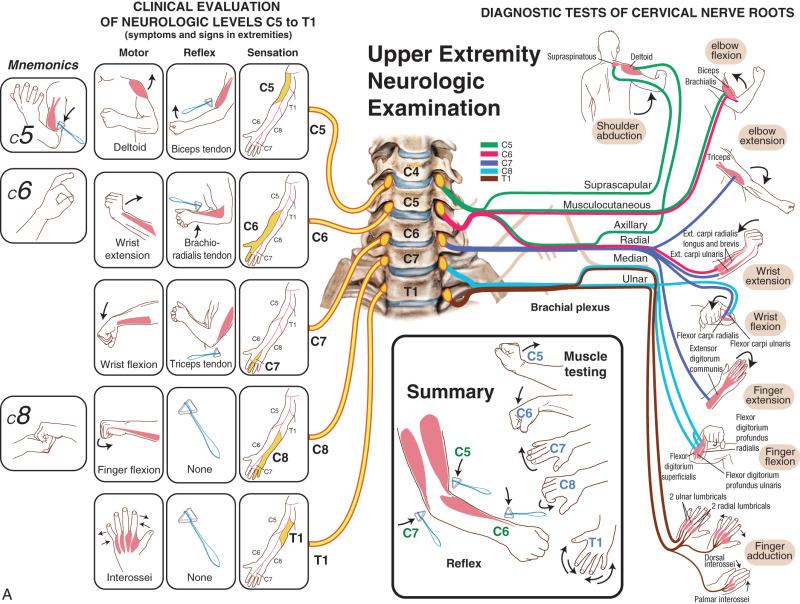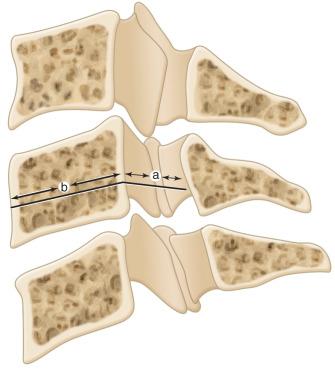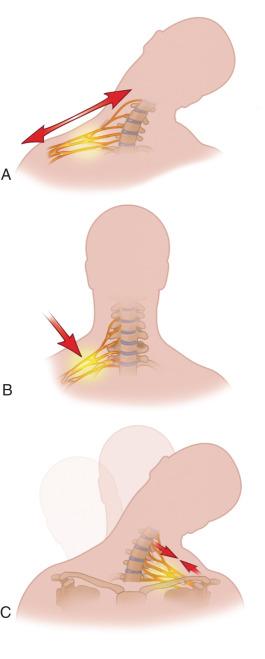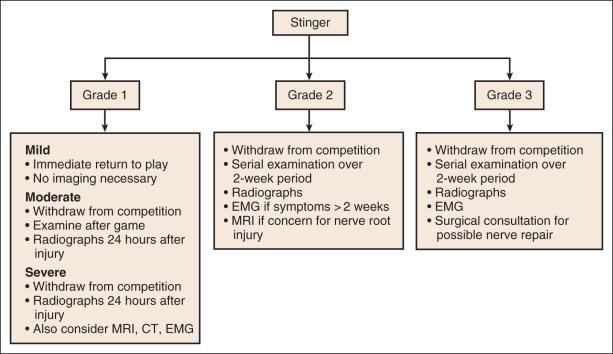Physical Address
304 North Cardinal St.
Dorchester Center, MA 02124
The terms “ stinger ” and “ burner ” are synonymous, and together represent a range of brachial nerve plexopathies. Initially described by Chrisman et al., stingers are almost invariably trauma-mediated, unilateral, reversible injuries of the upper extremity. While stingers are among the most commonly cited injuries of the cervical region, they are solely pathology of peripheral nerves. Most often, traction secondary to trauma will cause burning and paresthesia along a C5–C6 motor and sensory distribution, resulting in transient weakness and numbness The vast majority of cases resolve within minutes. However, in rare cases, symptoms may persist for weeks to months, resulting in significant impairment to quality of life.
Contact sports, particularly American football and rugby, are among the most commonly cited settings for stingers. Indeed, over half of all contact-sport athletes will develop a stinger during their career. While previous studies have found that up to 65% of football players report at least one stinger injury, recent work suggests a lower incidence of about 20% to 30%. Defensive ends/linebackers and offensive linemen appear to be at the highest risk. Similar estimates have been made among rugby players and wrestlers. However, some have called into question the accuracy of these figures, as stingers have traditionally been underreported. Recurrence is common, accounting for nearly one in five stinger injuries. Recurrent injury increases the risk of permanent nerve damage, which underscores the importance of proper athlete education and injury prevention. The purpose of this chapter is to review the history, exam, imaging, decision, and treatment options for the management of stingers. The authors will also discuss their preferred approach, return to play (RTP), and future considerations.
The most common setting of a stinger injury in the athlete is during play. Compressive trauma or traction occurs to an athlete whose neck is rotated contralateral to the blow. Such trauma may also depress the ipsilateral shoulder, increasing brachial plexus strain. Depending on the extent of injury, the patient may instinctually “shake out” the affected extremity, support it with the unaffected contralateral extremity, or report generalized pain in the area of the supraclavicular fossa. Compression, traction, and hyperextension injury are thus the three major mechanisms of stinger injury, and will be discussed with greater detail in a further section.
Pain from a stinger injury, true to its namesake, is frequently described as a burning paresthesia, with associated numbness and heaviness of the affected extremity. While the C5–C6 distributions are most commonly involved, circumferential rather than dermatomal radiation of pain down the extremity is not uncommon. Sensorimotor deficits, when present, typically rectify within several minutes. However, fewer than 1 in 10 patients may have residual symptoms lasting several weeks
A physical examination is warranted in any athlete with a suspected injury to the brachial plexus, as it can provide crucial details for further management. Evaluation initially begins with a focused cervical spine exam, followed by the characterization of musculoskeletal or neurologic abnormalities. Specific clinical exam techniques may then be used to identify the lesion location.
In the setting of apparent trauma to the neck, loss of consciousness, or gross deformity, the patient's cervical spine should be empirically immobilized until further imaging can be performed. Additionally, tenderness to direct palpation of the cervical spine in the presence of any trauma, even in the absence of obvious trauma, warrants application of a hard cervical collar. After the exclusion of cervical instability, basic evaluation of neck and extremity range of motion (ROM) and sensation should follow. It is important to note that stinger injuries are rarely bilateral, and do not affect the lower extremities; such signs point towards a more sinister pathology of the cervical spine.
Sensorimotor anomalies may be quickly and efficiently screened for on the field. Weakness of the deltoid and diminished wrist extension suggests C5 and C6 motor deficits, respectively. These findings, along with a reduction in lateral upper extremity and forearm sensation, represent the most common presentation of stinger injuries. Triceps weakness and reduced wrist flexion suggest C7 pathology, while weakness in finger flexion or medial forearm sensation suggests involvement of C8. A T1 abnormality, though rare, presents with loss or diminished sensation to the medial arm, and weakness of the intrinsic muscles of the hand ( Fig. 127.1 and Table 127.1 ).

| Muscle | Innervation | Clinical Test |
|---|---|---|
| Deltoid | Axillary (C5, C6) | Shoulder abduction |
| Supraspinatus | Suprascapular (C5, C6) | “Full can” abduction |
| Infraspinatus | Suprascapular (C5, C6) | External rotation |
| Biceps brachii | Musculocutaneous (C5, C6) | Elbow flexion |
| Pronator teres | Median (C6, C7) | Forearm pronation |
| Triceps brachii | Radial (C7, C8) | Elbow extension |
| Abductor digiti minimi | Ulnar (C8, T1) | Fifth digit abduction |
Evaluation of the native anatomy of the patient may also provide clinical information. The upper trunk of the brachial plexus runs superficially approximately 2 cm above the clavicle at the level of the C6 vertebral body. Known as the Erb point, this location describes the convergence of the C5 and C6 nerve roots. Direct palpation of the Erb point may elicit a Tinel sign—reproduction of numbness and tingling in the distal extremity along a C5–C6 distribution. The Tinel sign has both variable sensitivity (45% to 75%) and specificity (55% to 75%).
The Spurling test while traditionally used to evaluate for cervical spine radiculopathy, may also be positive in a stinger injury. A positive Spurling test involves the reproduction of paresthesia down the affected extremity upon turning the patients neck toward the side of the suspected lesion, extending the neck, and applying compression of forehead contralaterally. It is thought that the traction applied during a Spurling maneuver may reproduce the mechanism of the stinger injury, thereby also reproducing the symptoms of a stinger. The Spurling test appears to show 30% to 100% sensitivity and 75% to 99% specificity in the literature. Despite the question of variable sensitivity and intraobserver reliability, these examinations may provide useful evidence to an otherwise complicated clinical picture.
The supraspinatus and infraspinatus, along with the biceps and deltoid, appear to be most often involved in stinger injuries. In cases where a lesion of C5 or C6 nerve roots must be distinguished from an upper trunk lesion, a clinician may test for a long thoracic nerve or dorsal scapular nerve palsy. Involvement of either nerve may result in scapular winging, though long thoracic nerve palsy would result in medial winging during a Serratus wall test, while dorsal scapular nerve lesions exhibit lateral winging and rhomboid weakness.
Torg et al. first described the Torg ratio in 1986, a metric that is currently used to characterize cervical spinal stenosis. Originally, it was developed to radiographically predict the risk of developing chronic stinger syndrome in the otherwise healthy athlete. On lateral radiograph, the Torg ratio may be calculated by measuring the diameter of the spinal canal (distance from the midpoint of the superior and inferior endplates of the posterior aspect of the vertebral body to the corresponding point on the spinolaminar line). This distance is then divided by the anteroposterior (AP) vertebral body diameter to form the Torg ratio ( Fig. 127.2 ). Initially, a number of studies suggested that a Torg ratio below 0.7 to 0.8 indicated substantial spinal stenosis and increased risk of a future stinger during contact sports, with lower value corresponding to higher risk. Since the Torg ratio was first described, a number of subsequent studies have found it to have high sensitivity, but relatively poor predictive value and high user dependency. Although the Torg ratio is no longer widely used in the setting of stinger injuries, it nevertheless remains an important metric for the classification of cervical stenosis.

More recent literature has explored a novel method of predicting the risk for future stinger injury in the athlete. The mean subaxial cervical space available for the cord (MSCSAC) index—a measurement determined by averaging the difference between sagittal spinal cord diameter and sagittal spinal canal diameter from levels C3 through C6—appears to show some promise in this setting. In theory, any injury mechanism (e.g., hyperextension) that would diminish the MSCSAC would cause undue compression of the underlying cord, predisposing to recurrent stinger injury. In 2009, Presciutti et al. performed a comparison of 103 NFL athletes and 43 age-matched nonathlete controls. After obtaining cervical magnetic resonance imaging (MRI) and radiographs, the Torg ratio and the MSCSAC index were calculated for each subject. They found that MSCSAC was significantly different among athletes with and without chronic stingers, and among athletes and nonathlete controls. Furthermore, an MSCSAC index of less than 4.3 predicted a 13-fold increased risk of chronic stinger development, with 80% sensitivity and 96% specificity. A recent case study describing a Division 1 collegiate football player with chronic stinger syndrome also demonstrated findings consistent with those of Presciutti et al. While the effectiveness of the MSCSAC index as a predictive tool remains promising, further rigorous research in the form of prospective studies and clinical trials must be undertaken before the use of this method becomes widespread.
While imaging studies are not necessarily required in athletes with a suspected stinger injury, they may be critical for ruling out serious cervical pathology, particularly in those with prolonged, bilateral, or severe symptoms. In the past, lateral flexion and extension radiographs were often used to evaluate the cervical spine. Recently, however, a growing body of literature has supported the replacement of radiographs with computer tomography (CT). In a 2009 prospective study of 1505 patients brought to a level 1 trauma center, traditional radiographs were found to have poor sensitivity for cervical pathology (36%) when compared to CT (100%). When patients were stratified by low, medium, and high risk, based on mechanism of injury, this divide was even more pronounced in low-risk patients. Since then a number of studies, including large randomized trials, have found screening CT to exhibit superior sensitivity, specificity, interobserver, and intraobserver reliability when compared to radiograph, in both obtunded and nonobtunded patients. Furthermore, current research suggests that newer techniques of CT imaging, such as adaptive statistical iterative reconstruction (ASiR), may further increase the beneficial value of CT in this setting through reduction in radiation exposure by up to 36%. MRI may be used instead of CT when evaluating stingers in both adult and pediatric populations. In general, the acuity and severity of symptomatology should guide the decision to use MRI, which should be based on the individual patient's entire clinical picture.
Electromyography (EMG) has shown some utility in the evaluation of a stinger injury. In addition to differentiating preganglionic and postganglionic lesions, EMG can aid in determining lesion severity. Although the process of wallerian degeneration begins as early as 24 to 36 hours following injury, nerve segment distal to the lesion may continue to propagate normal signal pattern for up to 2 to 3 weeks. For this reason, EMG is indicated only for those patients with persistent symptoms for a minimum of 2 weeks. EMG findings may be variable, but commonly include normal to increased insertional activity, fibrillations and positive sharp waves at rest, and an incomplete interference pattern. Depending on the severity of nerve damage, postganglionic injuries do not appear to preclude spontaneous resolution, whereas preganglionic injuries or nerve root avulsions have little chance for recovery without surgical intervention.
Clinical decision-making, in the context of a stinger injury, necessarily relies on the mechanism of injury. To date, three mechanisms of injury have been explored in the literature These include direct compression of the Erb point, lateral traction of the brachial plexus, and cervical spine hyperextension ( Fig. 127.3 ). Each of these mechanisms can occur independently, or concomitantly with one another.

Compression of the superficial nerves at the Erb point is a frequently cited mechanism of stinger injury in the football player. During a direct tackle, the superomedial margin of the scapula can be forced towards a player's shoulder pad, or vice versa. The resultant compressive forces are then transmitted to the upper trunk of the brachial plexus that intervenes between these structures. Compressive injury also may occur as a result of any action that forcibly diminishes the diameter of the cervical foramina such as rapid head rotation or pre-existing cervical stenosis.
Brachial plexus traction is a common mechanism of injury in football players, but can also affect wrestlers, rugby players, bicyclists, and skiers. Injury occurs when the athlete head is forcibly bent contralateral to the affected side, and the ipsilateral shoulder is depressed. This can be the result of a direct tackle in the case of contact sports, or landing onto the side of an athlete's helmet following a high-speed fall (cyclists, skiers, etc.).
Hyperextension injuries can occur as a result of a head-on blow to the athlete, often with the force vector facing posteriorly. Here, rapid neck extension compresses the cervical nerve root through brief cervical foramen collapse, resulting in motor and/or sensory deficits. Athletes with degenerative disease of the cervical spine, such as stenosis or disk disease, are more prone to nerve root compression subsequently following a hyperextension event.
Besides the above mentioned three major mechanisms, in young athletes, stinger injuries may be associated with high magnitude acceleration of the head. In one study, Campolettano et al. analyzed 6813 impacts among 34 youth football players. They found that 6.0% of these impacts met the definition of “high magnitude” with head acceleration exceeding 40 g. Overall, the authors found that tackling drills during practice, rather than in-game injury, were responsible for up to 50% of high-magnitude impact exposures among young football players. Furthermore, specific tackling drills, such as the “King of the hill” drill, were strongly associated with head acceleration over 60 g.
Sir Herbert Seddon was among the first to describe injuries to the peripheral nervous system in 1942. Today, his classification scheme remains largely utilized to describe the severity of brachial plexus injuries. Stinger injuries are stratified into grade I, II, and III, with each grade describing varying levels of severity ( Table 127.2 ). Grade I injuries represent neuropraxia, in which conduction across a nerve is interrupted despite the presence of full axonal continuity. Although neuropraxias themselves can vary in severity, a key feature is that there is no violation of the epineurium, the perineurium, or the endoneurium of the affected nerve. Wallerian degeneration does not occur, and thus complete recovery is expected within days to weeks of the injury. On EMG, the patient may exhibit conduction block, positive sharp waves, and lack of fibrillation potentials.
| Grade | Nerve Injury | Electromyographic Findings | Prognosis |
|---|---|---|---|
| 1 | Neurapraxia | Normal | Most resolve within minutes |
| 2 | Axonotmesis | Positive waves with fibrillation | Recovery in 12–18 months |
| 3 | Neurotmesis | Acute denervation | Variable; possible complete loss of function |
Axonotmesis describes a peripheral nerve injury in which there is axonal disruption, and is indicative of a grade II stinger injury. Grade II stingers are more severe than grade I, but are fortunately less common. Because the epineurium and perineurium are preserved, grade II stingers, axonal regeneration remains possible without surgical intervention. Following injury, nerve conjunction transiently ceases, leading to significant sensorimotor deficits on the affected side. Wallerian degeneration then follows. At 3 weeks post injury, EMG may show some recovery of nerve conduction with fibrillation potentials and positive sharp waves. While symptoms may persist for weeks to months, full recovery can take over a year.
Grade III stingers exhibit neurotmesis and are thus the most severe. Neurotmesis involves complete or partial transection of the nerve, including endoneurium, perineurium, epineurium, and any myelinating cells in proximity to the injury. Conduction studies are variable, but can be similar to those found in grade II injuries if the affected nerve is only partially destroyed. Grade III injuries are accompanied by wallerian degeneration, severe sensorimotor, and/or autonomic dysfunction, and require prompt surgical intervention.
The initial treatment of a stinger injury centers on patient stabilization and removal from play. A thorough history and physical examination should be obtained as described in previous sections of this chapter. A high index of suspicion should be used when evaluating any injured player, as the patient may not immediately alert athletic trainers, especially when symptoms are transient.
Athletes with transient symptoms lasting only seconds, with complete resolution and benign physical exam findings, likely experienced a grade I, mild neuropraxia. Such patients can be managed symptomatically, and may be permitted to immediately RTP at the discretion of the athletic and coaching staff. Any player experiencing symptoms longer than a few seconds likely have a grade I, moderate neuropraxia, and should be removed from play for the remainder of the competition. Physical exam should be performed at the time of injury, at the end of play, and at 24 hours after injury for these individuals. The patient should also undergo cervical radiography, particularly if strength, ROM, and sensation has not returned to baseline. Treatment grade I, severe neuropraxia incorporates all of the above steps, and additionally includes repeated physical examination of the patient up to 2 weeks following injury. Additional imaging such as MRI or CT may be considered on a per-patient basis.
Serial examination and cervical imaging are also warranted in patients with grade II stingers. These patients should be closely followed for up to 2 weeks after initial injury, in a similar fashion to those with severe neuropraxia. Cervical imaging options include standard AP, lateral, and odontoid view radiographs, as well as MRI; CT also may be used if the patient develops symptoms suspicious of a cervical fracture.
Patients with grade III injury will exhibit severe weakness and sensorimotor dysfunction lasting more than 2 to 3 weeks. For these individuals, nerve conduction studies, such as EMG, are valuable for establishing nerve function and monitoring rehabilitation. MRI and conduction study findings should guide clinical decision-making, and surgical consultation is indicated for severe irreparable nerve damage.
Symptomatic treatment of nerve injury-related pain is indicated in all patients regardless of injury grade. First-line treatment includes the application of ice and the use of nonsteroidal antiinflammatory drugs (NSAIDs) to address local inflammation. Physical therapy is of value to those with symptoms that limit ranging of the cervical spine and the affected extremity. In this situation, an emphasis should be placed on regaining active and passive neck ROM, and improving the strength of musculature surrounding the site of injury. While the use of high-dose steroids remains contraindicated in patients with peripheral nerve injuries, a short course of low-dose oral steroids in patients with severe symptoms is generally accepted among most physicians. Similarly, cortisone injection near the site of nerve injury also may provide some symptomatic relief, though there are currently no concrete guidelines surrounding this. Muscle relaxants may be judiciously used in the patient with pain secondary to spasm of the musculature surrounding the injury.
Given the prevalence of stingers, the potential for life-altering complications and comorbid injuries, and the high propensity of underreporting observed throughout the literature, the authors advocate for the evaluation of all athletes exhibiting neurologic symptoms following in-game trauma. Any athlete sustaining symptoms that persist during sideline evaluation should be removed from competition and reevaluated after the game and 24 hours after injury. Unstable cervical injury should be managed according to local protocol; usually cervical CT should be obtained in patients exhibiting signs suggestive of fracture such as focal cervical tenderness. We find that initial CT imaging provides definitive information regarding cervical injury, and is generally appropriate for most injury patterns we encounter. Radiographs are an appropriate alternative if CT imaging is not available. If symptoms persist after 3 days, an MRI should be obtained. Serial imaging studies and exams are performed for 2–3 weeks following injury, until symptoms show improvement. If symptoms do not resolve at this time, EMG studies are obtained. We do not routinely use cortisone injections, oral steroids, or muscle relaxants, but do encourage rest, ice, the use of NSAIDs, and physical therapy when appropriate. Patients may be allowed to RTP following (1) complete resolution of pain, numbness, and tingling, (2) achievement of baseline muscle strength and ROM, and (3) subjective feeling of “readiness” to return to sport ( Fig. 127.4 ). The patient should be cautioned that recurrence of injury is common, and should be encouraged to use protective equipment in the future.

Become a Clinical Tree membership for Full access and enjoy Unlimited articles
If you are a member. Log in here